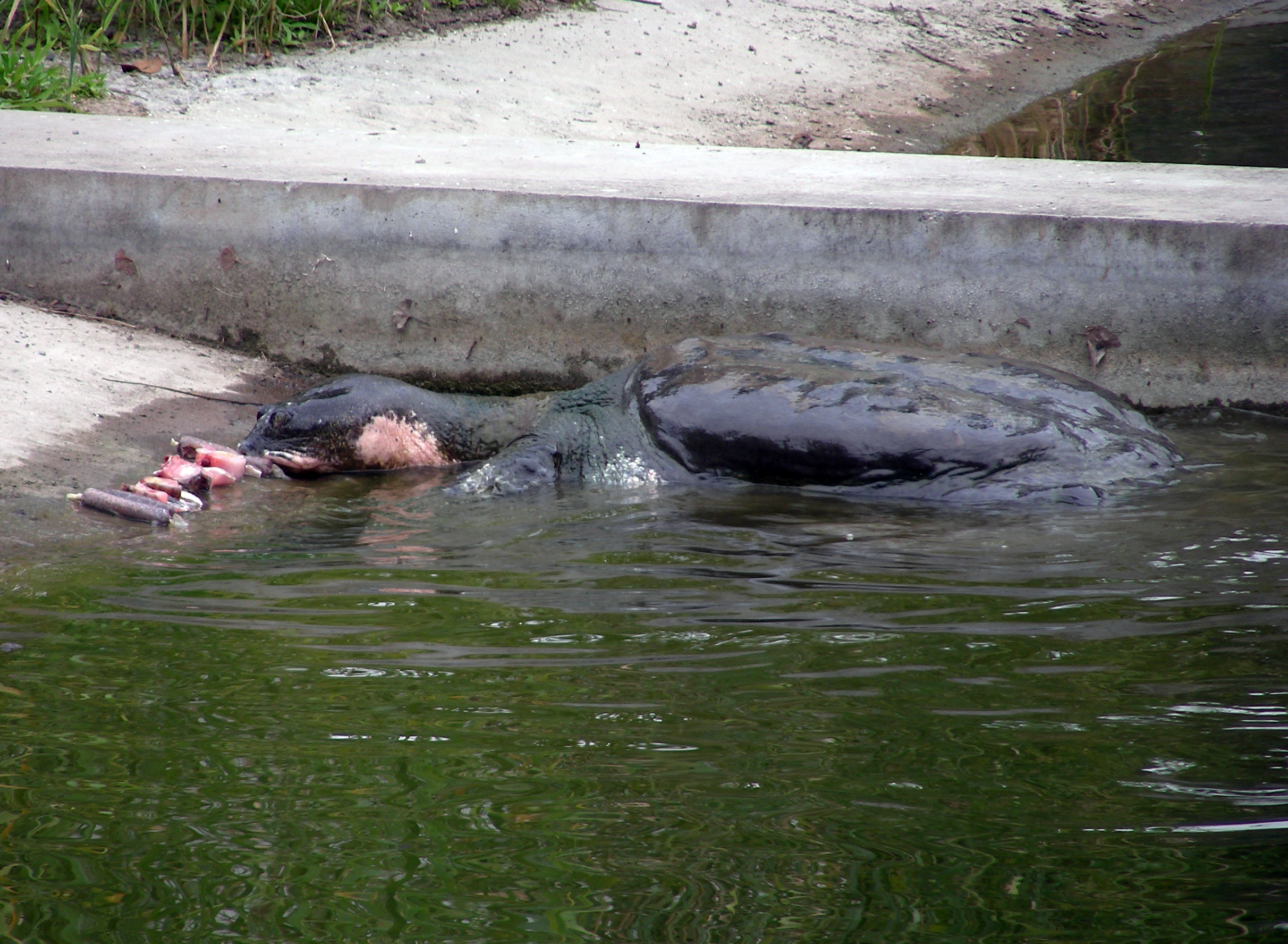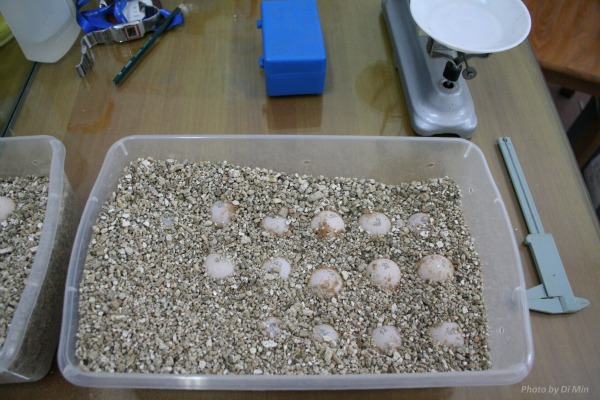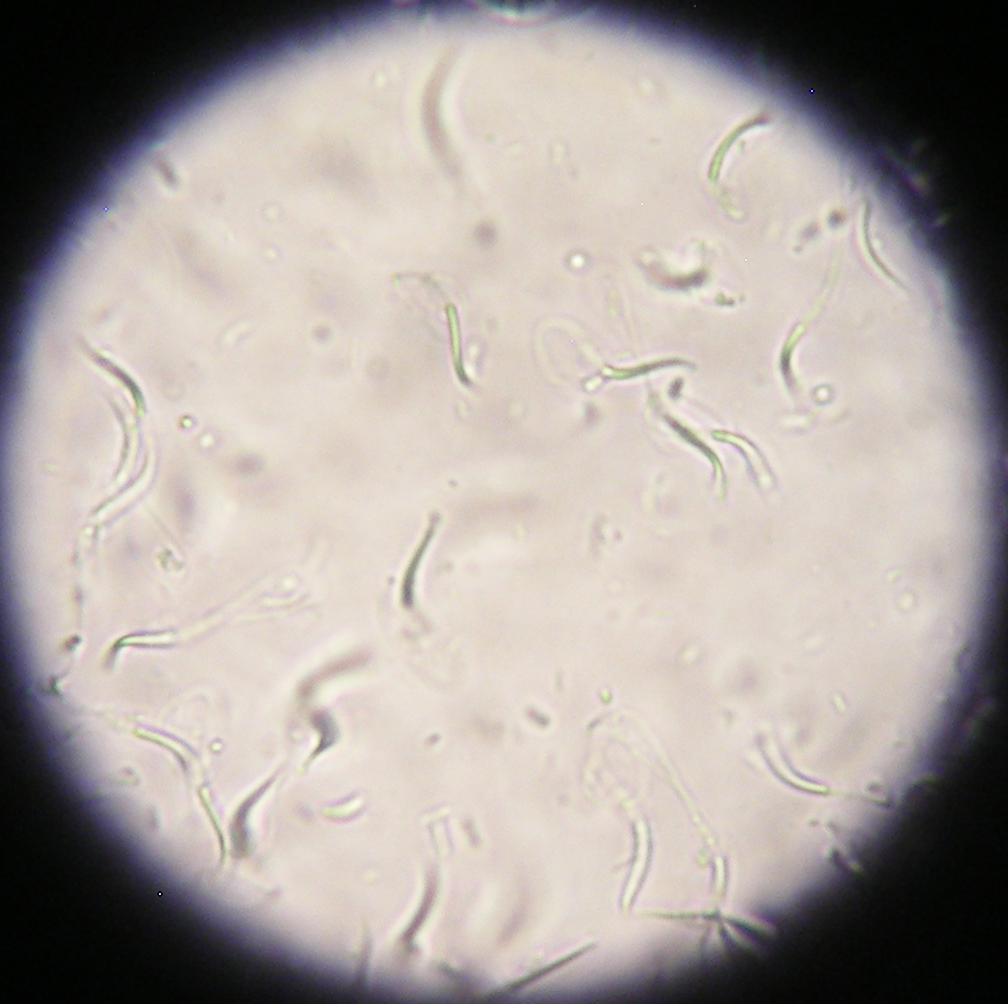Rafetus Breeding Attempt 2011
by Dr. Gerald Kuchling
 With the glass barriers around both ponds at Suzhou Zoo having been completed in the summer of 2010, the male and the female Yangtze giant softshell turtle (Rafetus swinhoei) have roamed together in both the small and the large pond since 24 August 2010. For the first time, the male and the female were together throughout fall, winter and spring. Following hibernation, the male and the female became active on 25 March 2011 when they both were seen basking. Abrasions on the neck and front limbs of the female when she emerged from hibernation indicated mating attempts during fall/winter (the male grabs the neck of the female with his jaws prior to mounting). The turtles' diet in 2011 consisted of pieces of fresh fish with skin and bones, whole freshwater crayfish, freshwater snails, sausages filled with a mixture of fresh, high quality minced fish, freshwater crayfish, prawns, egg shells, vitamin and calcium supplements, and chicken heads and wings. The sausages are readily eaten by both the female and the male, ensuring good nutrition.
With the glass barriers around both ponds at Suzhou Zoo having been completed in the summer of 2010, the male and the female Yangtze giant softshell turtle (Rafetus swinhoei) have roamed together in both the small and the large pond since 24 August 2010. For the first time, the male and the female were together throughout fall, winter and spring. Following hibernation, the male and the female became active on 25 March 2011 when they both were seen basking. Abrasions on the neck and front limbs of the female when she emerged from hibernation indicated mating attempts during fall/winter (the male grabs the neck of the female with his jaws prior to mounting). The turtles' diet in 2011 consisted of pieces of fresh fish with skin and bones, whole freshwater crayfish, freshwater snails, sausages filled with a mixture of fresh, high quality minced fish, freshwater crayfish, prawns, egg shells, vitamin and calcium supplements, and chicken heads and wings. The sausages are readily eaten by both the female and the male, ensuring good nutrition.
 The beach in the large enclosure was built up with sand in early June 2011. The female constructed her first nest on the eastern side of the new beach in the large enclosure (51 eggs, 11 with shell cracked) between 23:36 and 00:14 in the night from 07 to 08 June, her second nest on the western side of the new beach in the large enclosure (67 eggs, 5 with shell cracked) between 19:20 and 19:45 on 27 June, and her third nest high up on the beach of the small enclosure (70 eggs, 16 with shell cracked) between 21:28 and 22:07 on 10 July 2011. Three eggs of the first clutch, 14 eggs of the second clutch, and 8 eggs of the third clutch were left in the respective nests. The other eggs were artificially incubated in different substrates (sand, vermiculite, perlite) under wet (vermiculite/perlite : water = 1:1) and dry (vermiculite/perlite : water = 2:1) conditions and at four different temperatures (29, 31, 32, 33 °C).
The beach in the large enclosure was built up with sand in early June 2011. The female constructed her first nest on the eastern side of the new beach in the large enclosure (51 eggs, 11 with shell cracked) between 23:36 and 00:14 in the night from 07 to 08 June, her second nest on the western side of the new beach in the large enclosure (67 eggs, 5 with shell cracked) between 19:20 and 19:45 on 27 June, and her third nest high up on the beach of the small enclosure (70 eggs, 16 with shell cracked) between 21:28 and 22:07 on 10 July 2011. Three eggs of the first clutch, 14 eggs of the second clutch, and 8 eggs of the third clutch were left in the respective nests. The other eggs were artificially incubated in different substrates (sand, vermiculite, perlite) under wet (vermiculite/perlite : water = 1:1) and dry (vermiculite/perlite : water = 2:1) conditions and at four different temperatures (29, 31, 32, 33 °C).
I checked and candled all artificially incubated eggs on 14/15 June, 27 June, and 12/13 September 2011. In addition, Dr Lu Shunqing and Ms Emily King candled the eggs on 02 August 2011. Unfortunately, all eggs appeared to be infertile (non-fertilized). Thus, there is a reasonable possibility that the male did not inseminate the female, or, alternativeley, that he does not produce viable sperm. They have been together continuously since August 2010 and there were certainly several mating attempts and the female had a scarred neck in spring from mating bites, but obviously something did not work out.
Suzhou Zoo acquired red-eared slider eggs from a commercial turtle farm during May 2011 and incubated them under the same various conditions mentioned above for the Rafetus eggs. All those eggs showed signs of development (they were also candled) and most produced hatchlings, regardless of the setup. This demonstrates that there was no problem with egg incubation, but with the fertility of the Rafetus eggs. The Zoo also acquired 50 Chinese softshell hatchlings, 2 spiny softshell and two Florida softshell hatchlings during August 2011 to test the hatchling tank set up and to gain experience with raising softshell hatchlings.
 Very little is currently known on semen collection techniques, sperm quality criteria, and semen preservation for turtles. In May 2011, I started a preliminary investigation to collect and evaluate sperm from large male softshell turtles (Amyda cartilaginea) together with Dr. Wachira Kitimasak (Kanchanaburi Inland Fisheries Development Center, Thailand) and a veterinary team headed by Dr. Nantarika Chansue (Aquatic Animal Disease Research Center, Faculty of Veterinary Science, Chulalongkorn University, Thailand). We tried to collect semen from three large males: one without anesthesia and without electric stimulus, only by manual stimulation and by the use of a vibrator; one with anesthesia, manual stimulation and a vibrator; and one with anesthesia and electro-ejaculation, using a equipment normally used to collect semen from cats. We were only able to collect semen fluid from anesthetized turtles, but found good numbers of live spermatozoa only after electro-ejaculation. It appears to be necessary to use anesthesia plus electro-ejaculation to collect semen with good numbers of spermatozoa from big softshell turtles.
Very little is currently known on semen collection techniques, sperm quality criteria, and semen preservation for turtles. In May 2011, I started a preliminary investigation to collect and evaluate sperm from large male softshell turtles (Amyda cartilaginea) together with Dr. Wachira Kitimasak (Kanchanaburi Inland Fisheries Development Center, Thailand) and a veterinary team headed by Dr. Nantarika Chansue (Aquatic Animal Disease Research Center, Faculty of Veterinary Science, Chulalongkorn University, Thailand). We tried to collect semen from three large males: one without anesthesia and without electric stimulus, only by manual stimulation and by the use of a vibrator; one with anesthesia, manual stimulation and a vibrator; and one with anesthesia and electro-ejaculation, using a equipment normally used to collect semen from cats. We were only able to collect semen fluid from anesthetized turtles, but found good numbers of live spermatozoa only after electro-ejaculation. It appears to be necessary to use anesthesia plus electro-ejaculation to collect semen with good numbers of spermatozoa from big softshell turtles.
In early September 2011, Changsha Zoo announced that they intended to return the female Rafetus to Changsha. They intended to send her first to an exhibition in Wuhan (in central China) on 23 September 2011 where she would have been put on exhibit in a tank for up to two months. This would obviously have been worse than to send her directly to Changsha where she could have hibernated normally. On 13 September 2011, I, Lu Shunqing and Director Chen Daqing of the Suzhou Zoo flew together to Changsha for meetings with Director Xie and Assistant Director Yan Xiahui of the Changsha Zoo. We finally agreed that Suzhou Zoo will send a stuffed Rafetus specimen to the Wuhan exhibition (the Rafetus which was killed by the male in the 1990s) for educational purposes and that the female Rafetus will remain in Suzhou Zoo at least until next spring. This way the pair will have more chances to mate. In April 2012, we will do an examination and collect semen from the Suzhou male to find out if he produces sperm and, if he does, to artificially inseminate the female. Any further decisions about whether the female will then remain in Suzhou or move to Changsha will depend on the results of these endeavors.
From 16-21 September I was on a fact-finding mission along the Red River in southern Yunnan together with Dr Lu Shunqing and Dr Rao Dingqi (Kunming Institute of Zoology) to evaluate chances of finding new specimens of Rafetus swinhoei in the wild. I will present the results of this mission in a separate report.
Outlook
Given the Changsha Zoo’s impatience and assuming that copulation and sucessful insemination and not sperm quality might be the problem, we plan to try to collect semen from the Suzhou male in April 2012 to evaluate his sperm and to use it immediately to artificially inseminate the female (something the Chinese wanted to do in the first place). Given that we might have to perform anaesthesia and electro-ejaculation to do so, this is not without risk to this very old male – this was the reason why TSA objected to artificial insemination in 2007.
The second possibility would be to involve the male Rafetus of Dong Mo Lake in Vietnam in the breeding program. With the current political squabbles between Vietnam and China, it is highly unlikely any breeding loan can be arranged in the short term. Transporting semen from Vietnam to China after electro-ejaculation (assuming we can get all necessary permits) would not be nearly as straight forward as conducting the insemination with the animals side by side. In this case, we would have to experiment a bit more with Amyda semen and how best to keep it alive (temperature, any expanders, antibiotics etc). October or April might be a good time to do it, but with the necessary further experiments, negotiations, feasibility, permits, etc. this will be a medium to long-term plan.
The third approach could be to do a thorough survey in Yunnan (and may be in some lakes along the Yangtze) to try to find more Rafetus in China. I am currently preparing a proposal for a survey in May 2012.
